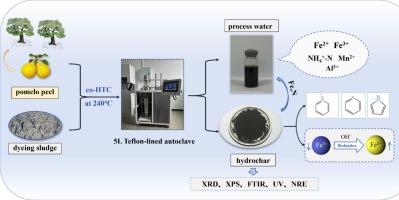柚皮与印染污泥共水热炭化条件下铁、氮的转化与迁移
IF 7.1
2区 环境科学与生态学
Q1 ENGINEERING, ENVIRONMENTAL
引用次数: 0
摘要
印染污泥中铁的含量较高,铁在与生物质共热炭化过程中的转化和迁移不可避免地影响了其他组分的行为,反之亦然。本研究通过一系列表征分析了在240℃不同PP/DS质量比条件下,柚皮(PP)和染色污泥(DS)共htc过程中Fe和N的迁移和转化机理。烃类的脱氮效率(NRE)高于计算值,N含量降低,部分N从固相向液相迁移,表现出正向的协同效应。固体中的氨基-N分别转化为稳定的N化合物吡啶-N (N-6)、吡咯-N (N-5)和石墨-N (N- q)。PP中的纤维素和半纤维素被co-HTC完全水解生成羟基(-OH)和醛(-CHO)基团,由于与蛋白质的协同作用,促进了Fe3+的还原,在DP2-8中效果最明显。同时,迁移到液相的Fe3+是否在固体表面重新富集取决于二次烃的分解和迁移速率,原料中PP的比例影响Fe2+/Fe3+的比例和Fe3+在液体中的迁移。原料的共htc处理提高了烃类的芳构化程度,从而改善了适合燃料应用的燃烧特性。本文章由计算机程序翻译,如有差异,请以英文原文为准。

Conversion and migration of iron and nitrogen under co-hydrothermal carbonization of pomelo peel and dyeing sludge
Dyeing sludge contained a high content of iron, which of conversion and migration during co-hydrothermal carbonization (co-HTC) with biomass inevitably influenced the behaviors of other components and vice versa. In this study, the migration and conversion mechanism of Fe and N in the co-HTC process of Pomelo peel (PP) and dyeing sludge (DS) under conditions of various PP/DS mass ratios at 240 °C was analyzed by a series of characterizations. The nitrogen removal efficiency (NRE) of hydrochar was higher than the calculated value, the N content decreased, and some N migrated from the solid phase to liquid phase, showing a positive synergistic effect. The amino-N in the solid was converted into stable N compounds, pyridine-N (N-6), pyrrole-N (N-5), graphitic-N (N-Q) respectively. Cellulose and hemicellulose in PP were completely hydrolyzed to generate hydroxyl (-OH) and aldehyde (-CHO) groups by co-HTC, which promoted the reduction of Fe3+ due to the synergistic effect with protein, with the most obvious effect in DP2-8. At the same time, whether the Fe3+ migrated to the liquid phase was re-enriched on the solid surface depended on the decomposition and migration rates of secondary hydrochar, the PP ratio in feedstock affected Fe2+/Fe3+ ratio and Fe3+ migration in liquid. The co-HTC treatment of feedstocks enhanced the aromatization degree of hydrochars, resulting in improved combustion characteristics suitable for fuel applications.
求助全文
通过发布文献求助,成功后即可免费获取论文全文。
去求助
来源期刊

Waste management
环境科学-工程:环境
CiteScore
15.60
自引率
6.20%
发文量
492
审稿时长
39 days
期刊介绍:
Waste Management is devoted to the presentation and discussion of information on solid wastes,it covers the entire lifecycle of solid. wastes.
Scope:
Addresses solid wastes in both industrialized and economically developing countries
Covers various types of solid wastes, including:
Municipal (e.g., residential, institutional, commercial, light industrial)
Agricultural
Special (e.g., C and D, healthcare, household hazardous wastes, sewage sludge)
 求助内容:
求助内容: 应助结果提醒方式:
应助结果提醒方式:


